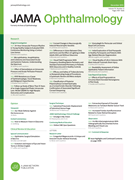In questo studio gli autori hanno testato l’utilità di un farmaco anti tumorale disponibile per via orale nel trattamento della maculopatia essudativa, al fine di evitare o ridurre le iniezioni intravitreali.
Sono stati studiati due gruppi di persone: il primo gruppo era di volontari sani, il secondo di malati di maculopatia essudativa.
Nei soggetti sani il farmaco è stato utilizzato per 14 giorni ed è risultato ben tollerato ai dosaggi prescritti, notevolmente inferiori a quelli impiegati nell’uso oncologico.
Nel gruppo di maculopatici, dopo 28 giorni di terapia, si sono avuti miglioramenti dell’acuità visiva e dello spessore retinico (-50 micron). È stato evidenziato un trend di associazione fra l’allele CFH Y402H T (basso rischio per degenerazione maculare senile) e il miglioramento.
Questo studio iniziale apre la speranza di poter trattare la maculopatia essudativa anche per via orale, oltre che mediante le ripetute iniezioni intravitreali. Occorreranno altri studi ed altre esperienze per poter iniziare a disporre di questa terapia nella pratica, ma gli inizi appaiono incoraggianti. Il pazopanib (nome commerciale Votrient) è utilizzato per i tumori al dosaggio di 800 mg / Kg, con considerevoli effetti collaterali, anche gravi. Nello studio per la maculopatia sono stati impiegati dosaggi estremamente più bassi, 15 mg/Kg, con una buona tollerabilità.
M.M. McLaughlin, M.G. Paglione, J. Slakter, M. Tolentino, L. Ye, C.-F. Xu, A.B. Suttle, R.Y. Kim
JAMA Ophthalmology
December 2013, Vol 131, No. 12
Importance Neovascular age-related macular degeneration (AMD) is managed with intravitreal anti–vascular endothelial growth factor therapy; however, the burden of care is high and alternate approaches could be beneficial.
Objective To identify an acceptable dose of oral pazopanib for investigation in AMD.
Design, Setting, and Participants Fourteen-day, placebo-controlled, dose-rising study in 72 healthy participants and 28-day phase 2a open-label study in 15 patients with subfoveal choroidal neovascularization secondary to AMD at a clinical unit for healthy participants and outpatient for patients with AMD.
Intervention Oral pazopanib tablets, 5 to 30 mg daily (healthy participants) and 15 mg daily (patients with AMD).
Main Outcomes and Measures Safety, pharmacokinetics, best-corrected visual acuity, central retinal lesion thickness, and central retinal thickness at day 29.
Results Oral pazopanib up to 30 mg daily in healthy participants and 15 mg daily in patients with AMD was well tolerated. Six of 15 patients received rescue therapy before day 29; all had the CFH Y402H CC “high-risk” genotype for AMD. Nine patients completed the study without rescue with improvements from baseline in best-corrected visual acuity (8 Early Treatment Diabetic Retinopathy Study letters), central retinal lesion thickness (−50.94 µm), and central retinal thickness (−50.28 µm). There was a trend for association between the CFH Y402H T allele (“low risk” for AMD, n = 6) and improvement.
Conclusions and Relevance Oral pazopanib (15 mg daily) was well tolerated and resulted in improvements in mean best-corrected visual acuity, central retinal lesion thickness, and central retinal thickness at day 29 in a per-protocol, nonrescued AMD population (n = 9). It is postulated that CFH Y402H genotype may help predict which patients respond to pazopanib. The size and length limitations of this study warrant further investigation to determine if oral pazopanib may be an appropriate treatment for a subset of neovascular patients with AMD or as an adjunct to standard of care.

 Initial exploration of oral pazopanib in healthy participants and patients with age-related macular degeneration
Initial exploration of oral pazopanib in healthy participants and patients with age-related macular degeneration